Florentine Pizza: A Gut-Friendly Recipe

Have you ever had an egg on pizza? It may sound strange at first, but once you give it a try, you’re likely to quickly become a fan. When cooked just right, egg pizza includes a mouth-watering burst of yolk, not to mention all the protein and other nutrients of eggs. Of course, this is assuming you like eggs and don’t have an egg allergy or intolerance. If eggs aren’t your thing, no worries because this Florentine pizza recipe makes eggs optional.
This Florentine pizza recipe combines a variety of really tasty, high-quality cheeses with tomato sauce, spinach, eggs and spice — so many tasty things in one place. That really is one of the best and most fun things about a homemade pizza, isn’t it? There’s no limit to what you can include. Maybe you’re in the mood for chicken florentine pizza? No problem, you can still use this recipe and just add some chicken to your toppings lineup! Whether you add or subtract a bit from this Florentine pizza recipe, your final product is sure to be loaded with flavor as well nutrients.
What Is A Florentine?
Using the word “Florentine” can have several different meanings. If someone asks you “What is a Florentine?” Well, if they are using it as a noun then you should respond by saying that a Florentine is someone from Florence, the city in Italy. But if they ask you “What is a Florentine ____?” Perhaps the blank is filled with “omelette” or, in this case, “pizza”. When florentine is used in this culinary fashion, it usually means that it is a dish that originates in Florence, Italy and/or that the dish features a bed of spinach as a main ingredient. When a dish is prepared à la Florentine, it will typically include spinach and often, it will also include eggs.
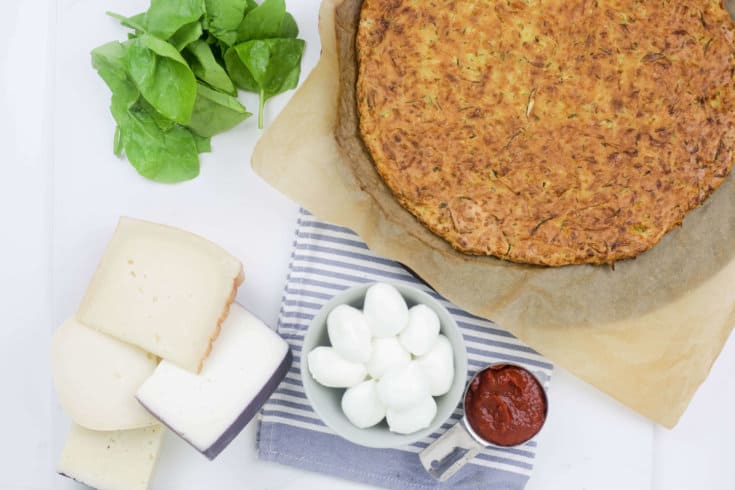
Nutrition Facts
This Florentine pizza recipe is loaded with nutrients. The valuable nutrition in this recipe comes from two parts: its crust and its toppings.
One serving of Florentine pizza (including the eggs and sauce) contains roughly the following:
- 270 calories
- 10.7 grams protein
- 16.6 grams fat
- 2.4 grams fiber
- 1.3 grams sugar
- 271 milligrams sodium
- 37 micrograms vitamin K (42 percent DV)
- 0.4 milligrams riboflavin (24 percent DV)
- 11 micrograms selenium (22 percent DV)
- 171 milligrams phosphorus (17 percent DV)
- 169 milligrams calcium (17 percent DV)
- 3 miligrams vitamin E (15 percent DV)
- 0.5 micrograms vitamin B12 (14 percent DV)
- 0.14 milligrams vitamin B2 (13 percent DV)
- 0.2 milligrams manganese (13 percent DV)
- 1.6 milligrams iron (13 percent DV)
- 508 IUs vitamin A (13 percent DV)
- 0.08 milligrams copper (10 percent DV)
- 34 milligrams magnesium (8.5 percent DV)
- 5 milligrams vitamin C (7 percent DV)
- 0.3 milligrams vitamin B5 (7 percent DV)
- 239 milligrams potassium (6.8 percent DV)
- 0.1 milligrams vitamin B6 (6 percent DV)
- 0.5 milligrams zinc (6 percent DV)
- 23 micrograms folate (6 percent DV)
So, as you can see, just a single serving of this Florentine pizza recipe contains 10 percent or more of at least 12 major nutrients! That’s quite impressive. What are some of the ingredients making this pizza such a nutritional powerhouse? Well, just to name a few:
Spinach: This key Florentine ingredient is on superfood lists for very good reason. For starters, spinach is significantly high in vitamin K, vitamin A, vitamin C, iron and folate. In addition, spinach has a rich content of phytonutrients called carotenoids, which studies have linked to improved eye and immune system health as well as a reduced risk of cancer and cardiovascular disease. (9)
Eggs: An egg is an excellent source of protein and it uniquely comes with a full amino acid profile. Eggs are also a really affordable way to incorporate more protein into your diet. In terms of nutrients, eggs are especially high in heart healthy selenium, riboflavin and vitamin D.
Zucchini: The star of this pizza’s crus is zucchini, which is has high amounts of potassium, vitamin C, vitamin B6 as well as fiber. The polysaccharide fibers, including pectin, found in zucchini are known for having a positive effect on blood sugar regulation. Zucchini crust is tasty and nutritious with less calories and carbs compared to a regular pizza crust.
How to Make Florentine Pizza
Once you have your crust made, you basically are throwing several ingredients on top to create a quick and easy Florentine pizza.
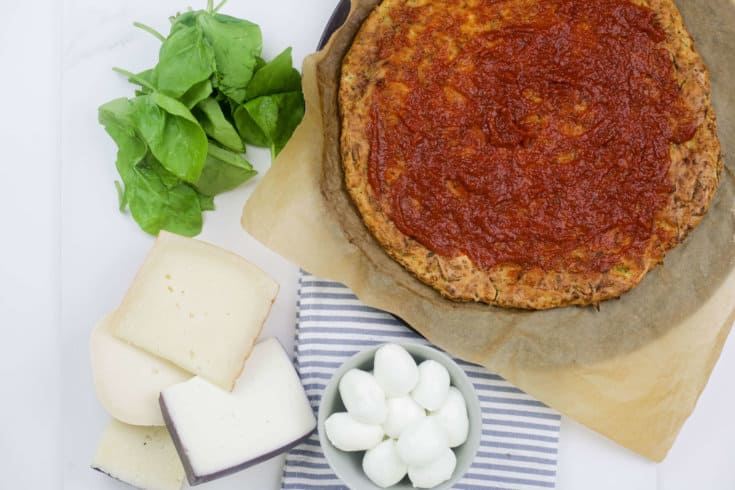
Once you remove the zucchini crust from the oven, you’ll want to add your tomato sauce (if you are including it) so it covers the crust evenly, leaving a little room around the edges like a typical pizza.
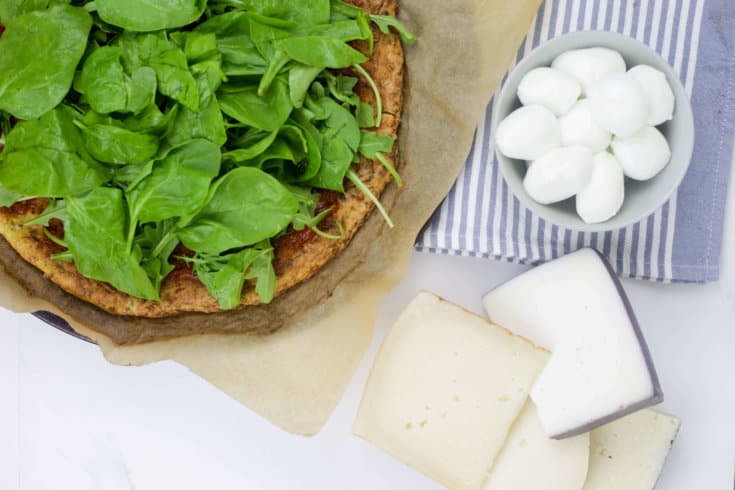
Next, add the fresh spinach and basil. Don’t worry if it looks like you’re putting way too much because both fresh greens will really shrink down once you cook them.
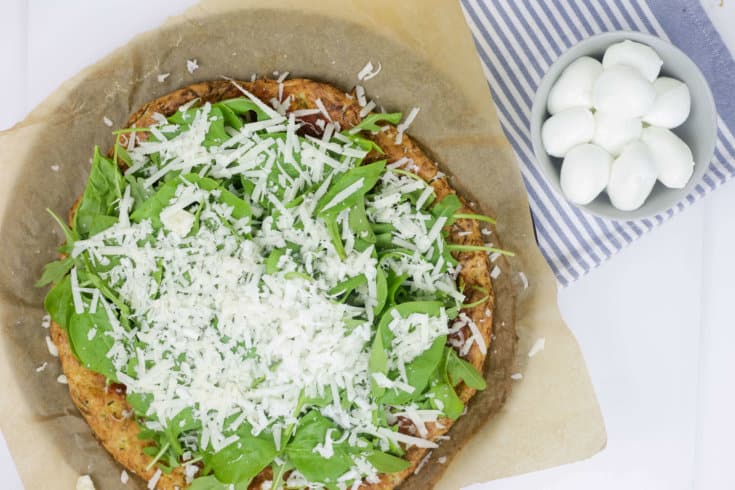
Now it’s time to add all of the delicious cheeses as well as the salt, pepper and spices.

Crack the four eggs on top, making sure to crack each one in a different area so the four eggs will basically cover the entire pizza. If you’re leaving the eggs out of your toppings, then simply skip this step.

It’s time to put this delicious Florentine pizza into the oven. How long should you cook? It’s actually up to you. If you’re including eggs, then cook your Florentine egg pizza until the eggs are cooked to your desired level of doneness. If you’re not including eggs, then cook it until all of the cheeses are melted and the crust is browned.
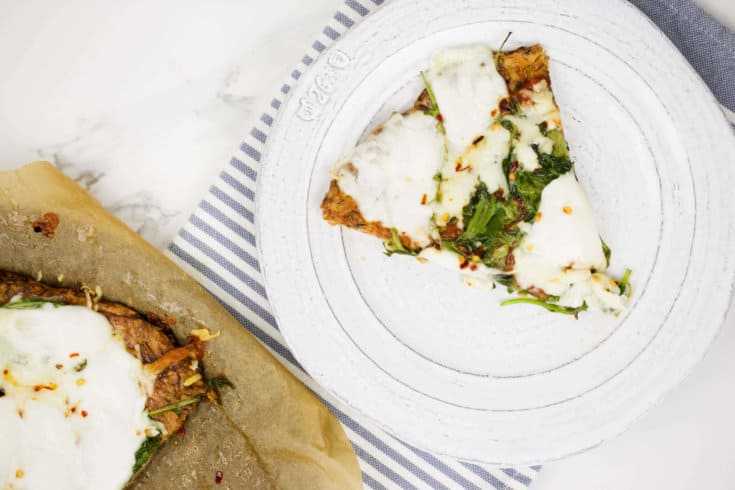
Let the pizza cool and cut into 8–10 slices before serving and enjoy!
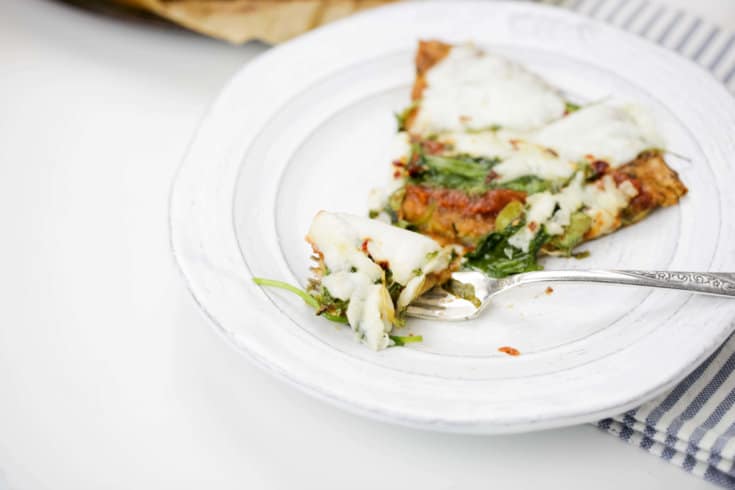
Total Time
1 hour 10 minutes
Serves
8–10
Meal Type
Diet Type
Ingredients:
- 1 zucchini pizza crust
- 2–3 tablespoons tomato sauce (optional*)
- 1–2 cups spinach
- ¼–½ cup basil, chiffonaded
- ¼ cup sun-dried tomatoes
- ¼ cup pecorino romano
- ¼ cup raw sheep cheese
- ¼ cup crumbled goat cheese
- ¼ cup buffalo mozzarella
- 1–2 teaspoons red pepper flakes
- 1 teaspoon black pepper
- 2 teaspoons oregano
- 4 eggs (optional*)
Directions:
- Preheat oven to 350 F.
- Cook the zucchini pizza crust.
- Remove crust from oven and add spinach, basil, sun-dried tomatoes, cheeses, spices and eggs.
- Cook pizza until eggs are cooked to desired doneness.
Comments
Please keep comments under 200 characters.




Will help you lose weight
After trying many other recipes for Gluten free pizza this is by far the best I’ve ever eaten. I followed the recipes adding all the ingredients fir the topping only thing I added not on the recipe was some cubed cooked chicken breast. I thought the amount of pepper flakes was way too heavy it overpowered everything else. Maybe 1/2 teaspoon would be enough. Well done Dr Axe it was great.
I am so glad you enjoyed this recipe, Shelley! I have also added cooked chicken breast to this recipe before. Great idea! Blessings.
Thank you for sharing your delicious receipes. Looking forward to more receipes.
I love the ingredients. However need more information about size and how many people the recipes feed. What size pizza pan?
I downloaded the free recipe book but the recipes do not say how many servings are made or what size those servings would be.
Please finish your lovely recipes :))
I really appreciate this recipe (especially the crust) but wow how can pizza containing dairy cheese be considered ‘Gut-friendly’? I’m glad cow’s cheese isn’t listed but usually, like I’m pretty sure you’ve stated in videos before, that those with gut conditions should discontinue dairy because the effect it has on the gut lining –those with wheat sensitivities/gut conditions also are generally sensitive to dairy as well. Nut cheeses are also super high in fat and make great soft cheeses for pizza time as well – that sounds like a better option.
Dairy from other animals was never designed for us and for full grown humans to eat anyways — milk is designed for growing babies. The only reason we still can eat it as adults is because we keep ingesting it regularly, else we’d develop a resistance to it. I wish you took a stronger stance on it and also talked about the effect it has on the build up of mucus in the lymphatic system, which leads to a whole host of health issues including the skin rashes, pimples and cancers.
<3
Well said Benjamin!! I was thinking the exact same thing whilst reading the ingredients list
Thanks Lee! Ever tried making nut cheese before? Cashew cheese would be amazing on this
Going dairy free did nothing to help my pimples, mucus congestion, bad digestion, bloating nor sensitive stomach so I guess it all depends on what works for you compared to facts and opinions.
I appreciate the link and I’ve heard how goat’s milk products are more easily ingestible than cow’s (makes sense because they’re a similar size to us). I have no doubt that ALL milk has great nutrient properties, because it is in fact designed by nature to grow babies really effectively. We’re not babies and we wouldn’t continue to drink the the milk of humans as we age? SO why consume products made from other animals’ lactations? If there wasn’t so much “intolerance” and gut issues going on out there I might be able to accept it, but if we really feel into it we know we’re feeding a bad addiction and calling it a ‘Healthy’ form of nutrition, even though its been shown to feed dis-ease in the body.
I’m not exactly sure how long the human has been drinking animals milk, but I’m sure it’s been a very long time and like other foods we have been eating, wheat, etc, it was probably okay for us in the beginning, but in the past 50 to 100 years humans have started processing those foods and our bodies have not been able to eat correctly those processed foods. I would think drinking raw milk and eating wheat that’s from many thousand years ago would be different to our systems then what we eat today.
Dr axe , You should try fathead Pizza Ketogenic approved fantastic recipe you can make garlic bread / focaccia it’s endless cal guilt free google it ??
Hi there,
Can you please tell me how many carbs per slice? Thank you.
Andrea, it’s about 2 grams of carbs per slice! I hope you enjoy!
Click on pizza crust . I wondered too
why was the pizza crust not given?????????
Hi Nona,
The pizza crust is linked in the article! I hope you have a wonderful day!
Sounds great! Thanks. So how do you make the zucchini crust?
Hi Nancy,
The pizza crust is linked in the article! I hope you have a wonderful day!